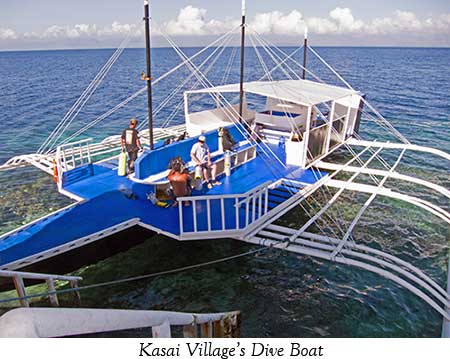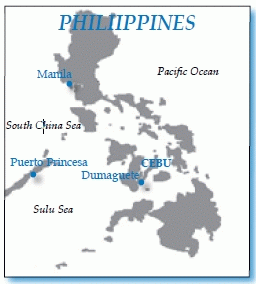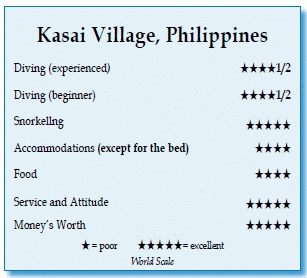Kasai Village, Cebu, PhilippinesContents of this Issue: Kasai Village, Cebu, Philippines Belize, Hawaii, Cozumel, Palau . . . The Reason for Wrinkled Fingers A Lost–at-Sea Diver Tells His Tale Comparing Dive Computer Watches Chinese Price Gouging and DCS Too Dead Divers’ Bad Mistakes: Part I Hey, There’s an App for that Dive Don’t Call Them “Shark Attacks” Anymore Editorial Office: Ben Davison Publisher and Editor Undercurrent 3020 Bridgeway, Suite 102 Sausalito, CA 94965 even a typhoon can’t affect the good diving from the March, 2013 issue of Undercurrent
Dear Fellow Diver: Here I was, on my third trip to the Philippines, searching for diving that really excited me, and we were about to be whacked by a major typhoon. Bopha was forecast to go right over Kasai Village on December 5. Suitcases were repacked "just in case," and everyone spent the evening huddled in the reception area, eating dinner and watching bad movies, planning to hunker down in the relative safety of the camera room if necessary. Luckily, we were spared, however, Bopha hit Mindanao, southeast of Cebu, causing mudslides, much destruction, and tragically, more than 1,000 deaths. Only the outer bands of wind and rain hit Cebu, so I can report that I did indeed find that great diving -- though I couldn't stop dwelling on the nation's great loss.
I can't pass up an anemonefish without taking its picture, and Copton Point had plenty. The terrain flattened at 66 feet, where a large turtle rested under the fuselage of a small plane wreck. My buddy and I worked our way up the slope, where hundreds of six-inch swimming pipefish fascinated me. A second trip here brought two turtles and a school of squid. Although the diving is similar all along the wall, each area also has its unique characteristics. During my 10 days, besides hundreds of pipefish and anemonefish, there were sea snakes, many turtles, several ghost pipefish, a variety of frogfish, schooling squid, dozens of nudibranchs, an occasional sea moth and devilfish, pygmy seahorses and hundreds of blind shrimp gobies. At my age, I can't spot pygmy seahorses, but I pointed my camera where Tata pointed, and one actually came out in focus! Although I didn't see any sharks, I did see one large bumphead parrotfish, and they say whale sharks and thresher sharks occasionally visit. At the end of many dives, I spent 15 minutes at the top of the wall, often in less than 10 feet of water, spying small crabs and nudibranchs, and watching schooling fish. Hard and soft corals were healthy everywhere. At Savedre Marine Sanctuary, dozens of large sea fans grew at least eight feet tall. We did a couple of dives at Pescador Island, 20 minutes away and crowded with dive boats, but its famed schools of sardines were missing. I liked diving off of Cebu better. Depending on your point of view, Kasai was either a lonely place, or a private one, with four to six guests most of the time. Four of us Americans were here the entire 10 days; a couple of Germans and Chinese joined us on the boat for a couple of days, but we mostly had the place to ourselves. To mix it up, we could take walks or go into town on a tut tut, but after those long dives, I was relaxed and in bed by 9:30. Meals were usually served upstairs, although once the windows were boarded up for the approaching Bopha, we ate one meal in reception and another day in the lower level of the dining hall, where the lone television and pool table reside. The potent Red Horse beer was popular at the sand-floor bar. Meals are normally served buffet-style, but we were so few that staff served us. Breakfast included eggs, a tasty Spanish omelet, delicious mango and banana pancakes, fruit and toast. Lunch could include an appetizer, one of several sandwiches or a smaller version of a dinner. Dinners offered a choice of chicken, beef, prawns, squid or fish, usually grilled, along with rice and vegetables. Salad and homemade soup were served first, and tasty desserts to finish. One day, all I really wanted for lunch was a peanut butter and jelly sandwich, but there was no peanut butter to be found -- next time I'm taking my own. The wait staff was ever so nice and polite, but the language barrier meant they didn't always bring forth the expected food.
At Tubla Wall, I saw four turtles, free-swimming pipefish, a leaffish, ghost pipefish, several nudibranchs, teenage sweetlips and a couple of orangutan crabs. At Fish Feeding, I saw two sea moths, devilfish, banded pipefish and a Titan trigger as big as they come, all on a sloping dropoff. Sampaquita had a bumphead parrotfish, a turtle, nudibranch eggs under a 10-inch-wide plate coral, spider crab in a sea fan, and lots of healthy hard corals in shallow water. Most dives were slow drifts in 82-degree water with minimal current. The afternoon boat dive went out at 3 p.m., which felt rushed sometimes because we didn't return from the morning dives until 1:00, and lunches were slow. Some divers skipped the afternoon dive, opting instead for dusk/night dives. The small Mandarinfish area was a bust on the first night, but on the second night, they hung out there forever. The night diving was non-stop action -- decorator crabs, cuttlefish, thousands of shrimp, congregating pipefish, hermit crabs and more, all above 35 feet. One night, we started at dusk on Kasai Wall, stopped off to watch the Mandarins at sunset, then finished with a night dive: a total of 105 minutes. The rules are no diving alone and no diving at night without a guide. We used 32-percent Nitrox on all dives. The short, wiry and strong Tata was my best guide ever -- very personable, always cheerful and great at finding things, but if I hung back taking pictures, that was OK with him.
The outstanding dive staff worked hard to provide us with the best possible dive experience. For each dive, they loaded up the tanks and equipment, rolled it down the long dock, laboriously transferred everything down the dock steps onto the boat, then did the reverse after our return. For the morning "Typhoon" dive, we were taken 15 minutes by car to a more protected cove. The staff carried all the gear down a hill into the water, helped us gear up, met us after the dive, gave us snacks, re-loaded the gear, and drove us back to the resort. In the van, the Chinese lady divers asked me "How do you get such a good body?" After almost choking from laughter because they were nearly four decades younger, I explained that diet and exercise were the key, and they looked just fine. My previous Philippines trips were to Dumaguete (Bahura Resort and Stella Maris liveaboard), and Puerto Galera (El Galleon, Atlantis Puerto Galera and the Atlantis Azores). This trip is the one I'll repeat. Tata went way beyond the call of duty, and I hope he's still at Kasai Village when I return. And I will -- J.R.
|

I want to get all the stories! Tell me how I can become an Undercurrent Online Member and get online access to all the articles of Undercurrent as well as thousands of first hand reports on dive operations world-wide
| Home | Online Members Area | My Account |
Login
|
Join
|
| Travel Index |
Dive Resort & Liveaboard Reviews
|
Featured Reports
|
Recent
Issues
|
Back Issues
|
|
Dive Gear
Index
|
Health/Safety Index
|
Environment & Misc.
Index
|
Seasonal Planner
|
Blogs
|
Free Articles
|
Book Picks
|
News
|
|
Special Offers
|
RSS
|
FAQ
|
About Us
|
Contact Us
|
Links
|
3020 Bridgeway, Ste 102, Sausalito, Ca 94965
All rights reserved.

 Depending on road traffic, Kasai Village Dive & Spa
Resort is a three- to five-hour van ride from Cebu City,
where my partner and I flew to nonstop after overnighting
in Hong Kong. Separated from nearby resorts, the new
Kasai Village is more private, though construction was
still winding down. My spacious oceanfront room, one of
nine, had a king bed, nightstands, desk, couch, wardrobe,
ceiling fan and air conditioning. The roomy bathroom had
a huge shower with
instant hot water
(but it would shut
down temporarily if
guests in other rooms
were showering; I was
advised a pump was on
its way to fix the
problem). And while
American hotels are
touting fluffy beds,
the nearly inflexible
pillows and the
rock-hard mattresses
here were unwelcoming and left me with sore hips. My room had a large
ocean-view patio with a table and two chairs.
The four smaller pool-view rooms had small
patios facing the pool. If any problems arose,
the smiling staff quickly addressed them.
Depending on road traffic, Kasai Village Dive & Spa
Resort is a three- to five-hour van ride from Cebu City,
where my partner and I flew to nonstop after overnighting
in Hong Kong. Separated from nearby resorts, the new
Kasai Village is more private, though construction was
still winding down. My spacious oceanfront room, one of
nine, had a king bed, nightstands, desk, couch, wardrobe,
ceiling fan and air conditioning. The roomy bathroom had
a huge shower with
instant hot water
(but it would shut
down temporarily if
guests in other rooms
were showering; I was
advised a pump was on
its way to fix the
problem). And while
American hotels are
touting fluffy beds,
the nearly inflexible
pillows and the
rock-hard mattresses
here were unwelcoming and left me with sore hips. My room had a large
ocean-view patio with a table and two chairs.
The four smaller pool-view rooms had small
patios facing the pool. If any problems arose,
the smiling staff quickly addressed them. Three boat dives a day plus unlimited shore
diving is the advertised enticement, but in
reality, I only had time for three dives daily
because 70-minute dives and surface intervals
ate up the clock. The roomy dive banca had a
large covered area, dry shelves and back-toback
tank racks in the middle. The bow had the
typical long nose that I stepped onto from the
steps leading down from the dock; it got a bit
tricky if it was choppy. When the tide flows
from the rocky shoreline, the ocean bottom is
exposed quite a ways out. Locals wade out
or snorkel with containers, looking for anything
edible. Some staffer was always happy to
buddy up with a lone shore diver, and most of
our boat dives were along that wall, sometimes
traveling no more than 30 seconds from dock to dive. I saw no stingrays, octopus
or lobsters during my 10-day trip, and Tata, my fortysomething local dive guide,
said they're pretty much gone.
Three boat dives a day plus unlimited shore
diving is the advertised enticement, but in
reality, I only had time for three dives daily
because 70-minute dives and surface intervals
ate up the clock. The roomy dive banca had a
large covered area, dry shelves and back-toback
tank racks in the middle. The bow had the
typical long nose that I stepped onto from the
steps leading down from the dock; it got a bit
tricky if it was choppy. When the tide flows
from the rocky shoreline, the ocean bottom is
exposed quite a ways out. Locals wade out
or snorkel with containers, looking for anything
edible. Some staffer was always happy to
buddy up with a lone shore diver, and most of
our boat dives were along that wall, sometimes
traveling no more than 30 seconds from dock to dive. I saw no stingrays, octopus
or lobsters during my 10-day trip, and Tata, my fortysomething local dive guide,
said they're pretty much gone. After breakfast, we left the dock by
9 a.m. for the two morning dives. During
the hour-long interval between them, we
were served water, hot tea or coffee,
fruit and snack crackers. Entries were
giant strides, and an angled ladder was
lowered for climbing back into the boat.
The ladder didn't go far enough into the
water to step onto it with a tank on my
back, so I used a knee and then stepped
up. A guide would gently tug on the tank
at the top of the ladder, if necessary.
One gentleman had back problems and was
able to take off his tank before climbing the ladder.
After breakfast, we left the dock by
9 a.m. for the two morning dives. During
the hour-long interval between them, we
were served water, hot tea or coffee,
fruit and snack crackers. Entries were
giant strides, and an angled ladder was
lowered for climbing back into the boat.
The ladder didn't go far enough into the
water to step onto it with a tank on my
back, so I used a knee and then stepped
up. A guide would gently tug on the tank
at the top of the ladder, if necessary.
One gentleman had back problems and was
able to take off his tank before climbing the ladder. Kasai's impressive camera room had about 15 separate work areas, each with a
converter and several electrical outlets; there was a fan but no air conditioning.
The open-air dive storage area had lots of rinse tanks, water hoses, benches,
hangars for BCs and wetsuits, a waistlevel
hanging rod and a storage shelf above.
Floors in both areas were covered in nonskid,
ventilated rubber matting.
Kasai's impressive camera room had about 15 separate work areas, each with a
converter and several electrical outlets; there was a fan but no air conditioning.
The open-air dive storage area had lots of rinse tanks, water hoses, benches,
hangars for BCs and wetsuits, a waistlevel
hanging rod and a storage shelf above.
Floors in both areas were covered in nonskid,
ventilated rubber matting. Divers Compass: My 10-night trip cost $2,339 per person, and
included lodging, diving and three meals a day; staff will pick
you up at the airport, and round-trip transfers are about US$50,
but it depends on the number of people in the van . . . The
marine park fee ran about US$5 a day; Nitrox cost me $200 for the
whole trip . . . Bring your own tissues, or use toilet paper,
and a small travel pillow would be a decent replacement for the
resort's . . . Prepare yourself for mosquitoes in the evening when
the wind is calm . . . Website:
Divers Compass: My 10-night trip cost $2,339 per person, and
included lodging, diving and three meals a day; staff will pick
you up at the airport, and round-trip transfers are about US$50,
but it depends on the number of people in the van . . . The
marine park fee ran about US$5 a day; Nitrox cost me $200 for the
whole trip . . . Bring your own tissues, or use toilet paper,
and a small travel pillow would be a decent replacement for the
resort's . . . Prepare yourself for mosquitoes in the evening when
the wind is calm . . . Website: 